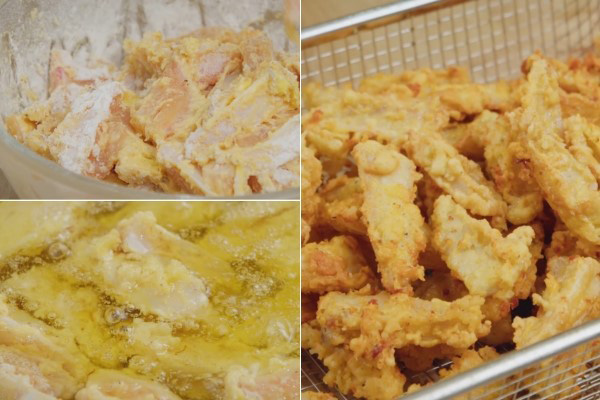Sụn Gà Rang Muối (Salted Chicken Cartilage)
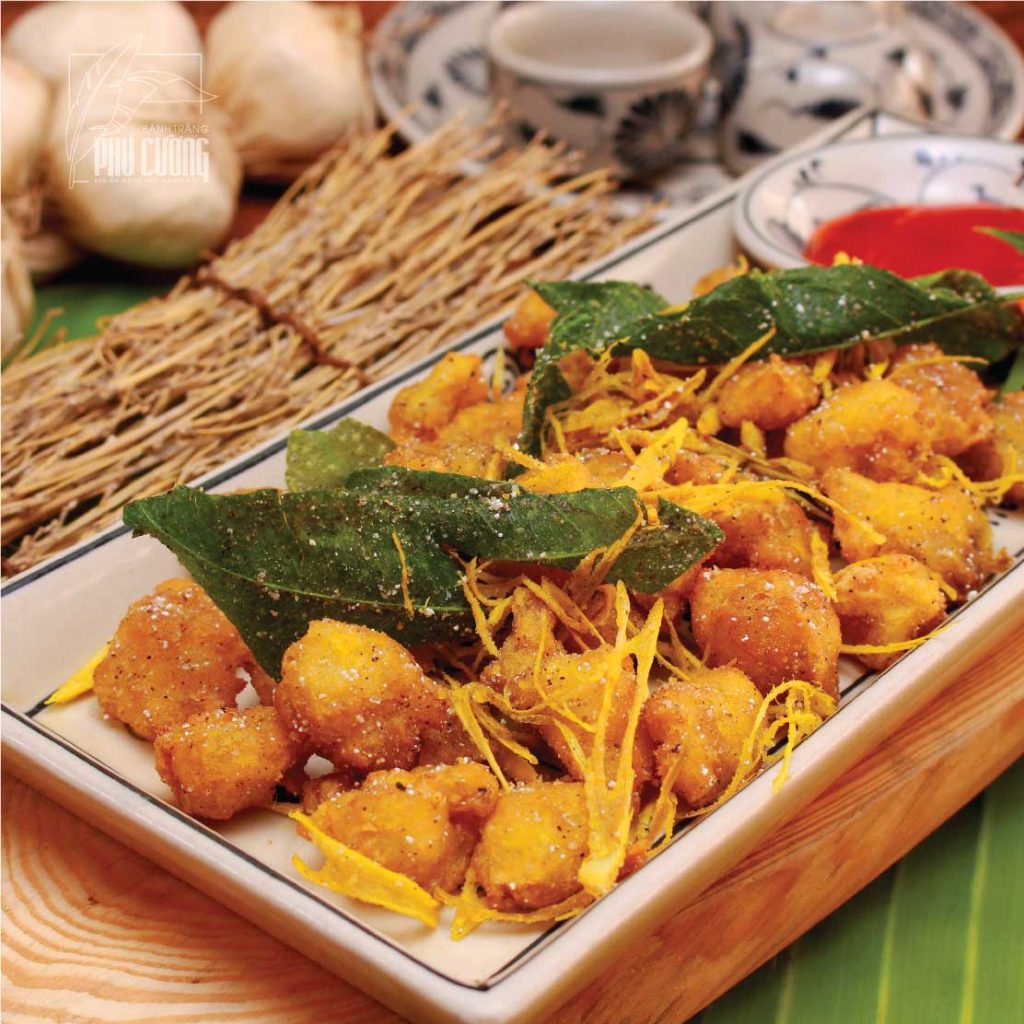
Ingredients
Main Protein & Crunch Layer
-
950g chicken cartilage (sụn gà)
-
3 egg yolks
-
Coating: Crispy flour (bột chiên giòn)
Aromatics & Herbs
-
5 lemongrass stalks (thinly sliced)
-
1 small ginger (julienned)
-
4 shallots (sliced)
-
6 garlic cloves (sliced or minced)
-
1 chili (sliced)
-
Kaffir lime leaves (lá chanh, julienned)
Salt Crust Mix
-
25g dried shrimp
-
25g mung beans (hulled)
-
95g instant rice porridge flakes
-
50g glutinous rice
-
10g whole peppercorns
-
30g rock salt
(These are all toasted separately, then ground and mixed to make muối rang.)
Seasoning
-
Fish sauce, MSG, chili powder, pepper, chicken bouillon, sugar – to taste
How To Buy Fresh Chicken Cartilage
- When buying chicken cartilage, look for pieces with minimal meat attached and a fresh pink color. Avoid cartilage with dark spots or bruises, as they may indicate poor quality.
- If you’re buying pre-packaged cartilage, check the expiration date carefully and make sure the packaging is intact, without any tears or damage.
- Fresh cartilage should have a mildly fishy smell typical of raw poultry. Do not buy any that have an unusual odor or slimy texture.
- You can choose either breast cartilage or thigh cartilage depending on your preference—both offer a satisfying crunch when cooked properly.
Nutritional Information
For: Omnivores
Calories per serving: ~300–350 kcal (per ~200g cooked portion)
Key Nutrients
1. Collagen & Protein (15–20g)
- Source: Chicken cartilage (sụn gà)
- Benefits: Collagen supports joint, skin, and bone health; protein aids muscle repair and satiety.
2. Natural Fats (12–15g)
- Source: Egg yolk, deep-frying oil, and natural chicken fat
- Benefits: Provides energy and enhances nutrient absorption—should be consumed in moderation.
3. Complex Carbs & Fiber (15–18g)
- Source: Toasted glutinous rice, mung beans, rice porridge flakes (cháo ăn liền), and tôm khô
- Benefits: Slow-release energy, adds crunch, and supports gut health with prebiotic compounds from legumes.
4. Antioxidants & Bioactives
-
Allicin (garlic, shallots): Boosts immunity, heart health
-
Capsaicin (chili): Promotes circulation and metabolism
-
Citral & Flavonoids (lemongrass + lime leaves): Anti-inflammatory and antimicrobial
-
Gingerol (ginger): Supports digestion and reduces nausea
5. Essential Minerals
-
Calcium + Phosphorus (cartilage): Supports bone and joint structure
-
Iron & Zinc (egg yolk + dried shrimp): Crucial for oxygen transport and immune function
-
Sodium (salt + fish sauce): Enhances flavor – best enjoyed in moderation
1. To make the savory salt-roasted powder, prepare the following ingredients: dried shrimp, hulled mung beans, instant porridge flakes, glutinous rice, whole black pepper, and coarse salt.
-
Dry-roast each ingredient separately until golden and fragrant.
-
Grind them into a fine powder, then mix them all together in a bowl.
-
Store the powder in an airtight container for future use.
Notes:
-
Only roast until golden brown; over-roasting can cause bitterness.
-
You can make this powder in bulk to save time when preparing salt-roasted dishes.
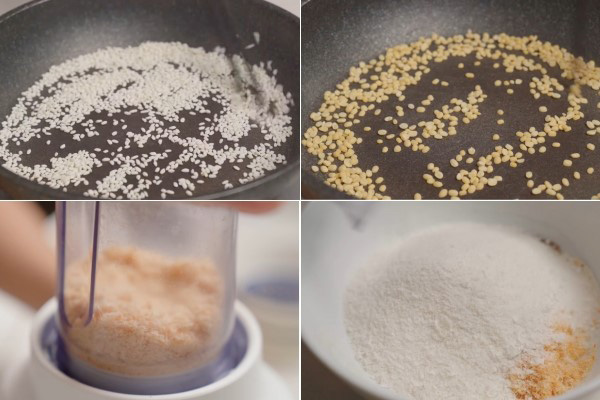
2. Marinating Chicken Cartilage
-
Peel and mince shallots and garlic, then extract the juice using a strainer.
-
Rinse the chicken cartilage thoroughly with salt, ginger, and water, then let it dry.
-
In a mixing bowl, combine cartilage with:
-
the garlic-shallot juice
-
1 tsp seasoning powder
-
½ tsp ground pepper
-
1 tbsp fish sauce
-
3 egg yolks
-
-
Mix well and marinate for 20 minutes.
Note: If you’re using pre-seasoned crispy flour, adjust the marinade to avoid excessive saltiness.
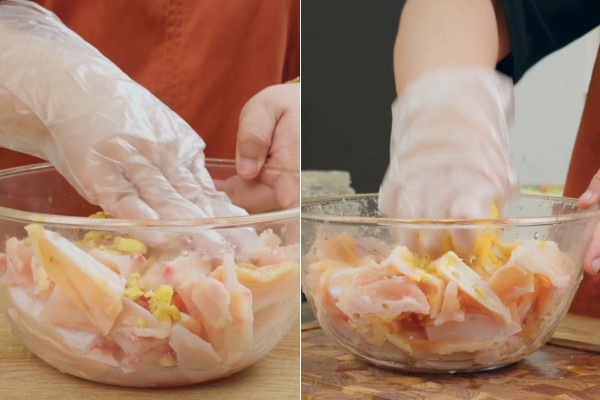
3. Preparing Lemongrass & Kaffir Lime Leaves
-
Peel and thinly slice lemongrass.
-
Wash and finely shred kaffir lime leaves.
-
Thinly slice red chili (deseeded).
Fry lemongrass in hot oil over medium heat until crispy and golden. Stir constantly to avoid burning. Once done, drain on paper towels.
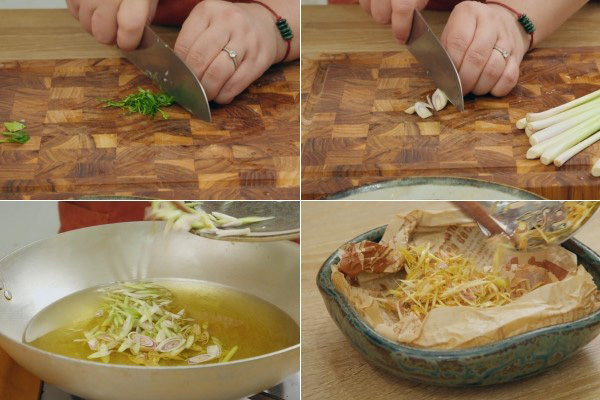
4. Frying Chicken Cartilage & Tossing with Salt Powder
-
After marination, coat the cartilage evenly with crispy flour.
-
Use the oil left from frying lemongrass (for added aroma) to fry the cartilage over high heat until golden and crispy.
-
Drain the cartilage well.
In a large bowl, toss the cartilage with the salt-roasted powder. Add half of the fried lemongrass, then toss again to infuse fragrance.
Tips:
-
Sift the crispy flour beforehand to avoid clumps.
-
Add a pinch of lion’s powder (annatto powder) if you want a more golden appearance.
-
Gradually sprinkle the salt powder and taste as you go to ensure balance.
5. Final Product
- Plate the crispy chicken cartilage, then top with the remaining fried lemongrass, lime leaves, and chili strips. This dish is best served hot, offering an addictive mix of crunchiness, savory saltiness, and zesty citrus aroma.
- Serve with fresh herbs or greens to lighten the flavor. Pair with chili sauce, ketchup, or even mayonnaise for extra indulgence—perfect for sharing with friends over drinks!
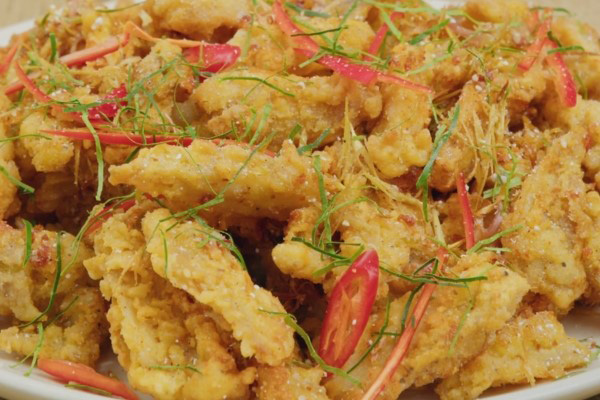
Crunch, Heat, and a Sip of Beer — The Spirit of Vietnamese Nhậu Culture
In the heart of Vietnamese street food culture, few things are more cherished than the communal act of “nhậu” — casual drinking sessions with good friends, loud laughter, and a table filled with small, flavorful dishes designed to accompany a cold beer.
Among the most addictive “nhậu” staples is Salted Chicken Cartilage — a dish that celebrates texture over tenderness, aroma over complexity, and boldness over subtlety.
What makes this dish special is not just its satisfying crunch or the lingering salt-pepper heat on your tongue, but the way it brings people together. Whether it’s served on a sidewalk eatery with tiny plastic stools, or in a family backyard gathering, this dish invites conversation, nostalgia, and the warmth of Vietnamese hospitality.
The addition of crispy lemongrass and lime leaves isn’t just a flavor enhancer — it’s a reminder of home gardens and rustic kitchens. The crackle of cartilage, the aroma of fried herbs, and the burst of seasoning from the salt powder mimic the energetic, layered chaos of a Vietnamese street at dusk.
Pair it with a glass of ice-cold beer, and suddenly, it’s not just a dish — it’s a moment.
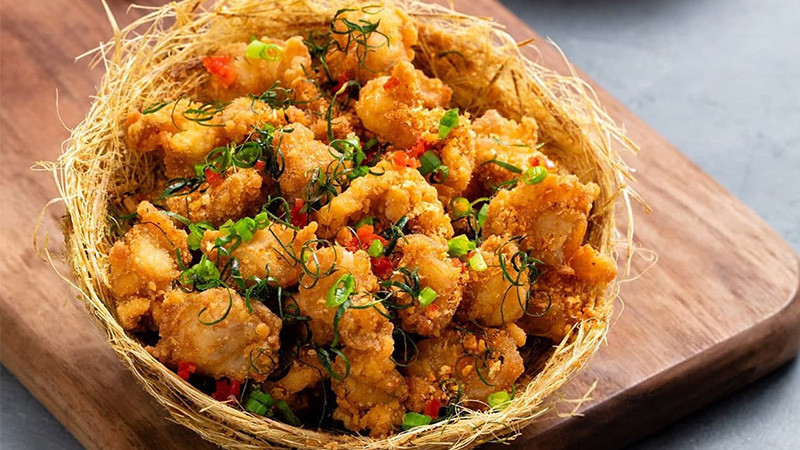
(Crispy Salted Chicken Cartilage)
